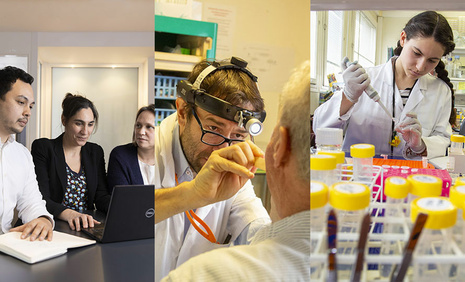Our history
Institut Curie was born out of the determination of one woman, Marie Curie, and one important cause: the fight against cancer.

12 December 1909: The University of Paris and Institut Pasteur decided to build the Institut du Radium for Marie Curie, winner of the 1903 Nobel Prize for physics along with her husband Pierre Curie and their colleague Henri Becquerel, for their work on radioactivity. This laboratory was set up just a few streets away from the “hangar” at the school of industrial chemistry and physics, where Pierre and Marie Curie discovered radioactivity along with polonium and radium in 1898.
The goal was to study radioactivity and its applications in physics, chemistry, biology and medicine. The set-up was very original for its time: the Institut du Radium featured the Curie laboratory, directed by Marie Curie and entirely devoted to physics and chemistry research, and the Pasteur laboratory, directed by Dr. Claudius Regaud and devoted to studying the biological effects and medical applications of radioactivity.
In 1911, while her future laboratory was being built on the rue Pierre-Curie in Paris’ 5th arrondisssement, Marie Curie won her second Nobel Prize. This time it was for chemistry, awarded for her work in isolating metallic radium and determining its atomic mass. Today, she remains the only woman to have ever won two Nobel Prizes. Once the war ended and they settled into their respective laboratories, Marie Curie and Claudius Regaud proposed a general development project for the Institut du Radium, where research and therapeutic applications would be closely linked. This well-known research-care continuum, developed by Marie Curie and Claudius Regaud, is still the hallmark of Institut Curie a century later, and its innovations are based on this fundamental mainstay.
The Curie model
The Curie Foundation, created in 1920 under the dual patronage of the Institut du Radium and the Institut Pasteur with financial backing from Henri de Rothschild, was recognized as a public-interest institution the following year. Its purpose was to finance the research activities of the Institut du Radium and allow medical applications to be offered to patients under optimum conditions. The Curie Foundation was also behind the opening of a dispensary on the rue d’Ulm in 1922. In synergy with the Curie laboratory, Dr. Claudius Regaud and his team developed innovative treatments combining surgery and brand-new radiotherapy methods to treat cancer.
This pioneering center for radiotherapy immediately became a model for new cancer centers in France and abroad. The Curie laboratory was internationally renowned for research in physics and chemistry; researchers from all around the world came to be trained by Marie Curie. In 1921, there was a collection in the United States to give Marie Curie a gram of radium needed for her research. In 1929 she was provided with a second gram of radium by American donors; she donated it to the University of Warsaw in Poland. In 1934, shortly before Marie Curie’s death, her daughter Irène and son-in-law Frédéric Joliot-Curie synthesized new radioactive elements at the Institut du Radium. So-called “artificial” radioactivity would come to be a formidable tool for scientific and medical uses of radiation such as imaging, diagnosis and radiotherapy, and it earned them the Nobel Prize for Chemistry in 1935. Meanwhile, the influx of patients to the dispensary made it clear that a hospital was urgently needed. A government subsidy made that hospital a reality in 1936, and it was extended 10 years later thanks to an anonymous Canadian donor. In the late 1950s, new nuclear physics and radiobiology laboratories opened at Orsay (in the Essonne region), under the impetus of Irène and Frédéric Joliot-Curie.
The Institut du Radium and the Curie Foundation merged in 1970 to form Institut Curie, with the three missions of research, teaching, and treating cancer. Since then, considerable real estate acquisitions, constructions and renovations have helped these laboratories and hospitals adapt to meet the needs of both research and patients. These include the “Maison des Parents” Irène-Joliot-Curie (1989), the medicalization of the synchrocyclotron into a Protontherapy Center (1992), and the Developmental Biology and Cancer department (2008), which houses new laboratories. On 1 January 2010, Institut Curie and René Huguenin cancer center (in Saint-Cloud, Hauts-de-Seine region) merged to better face the challenges of oncology.
A leading player in the fight against cancer, Institut Curie now boasts an internationally-renowned research center with a state-of-the-art hospital group, which treats patients suffering from some of the rarest cancers. Located at three sites (Paris, Saint-Cloud and Orsay), it has over 3,300 researchers, physicians and caregivers collaborating on its three missions: treatment, research and teaching. An ambitious architectural project – with a new hospital at Saint-Cloud in 2020 and fully redesigned laboratories – now represents a powerful ally in the MC21 (Marie Curie 21st Century) institutional project, offering patients the very best.


